Here you can find the best cantucci recipe to make at home! Cantucci are the most famous traditional Tuscan cookies, made with flour, butter, eggs and almonds.
Their characteristic is an unmistakable shape made by cutting a freshly baked loaf of dough into oblique slices. A second step in the oven for a few minutes serve to give the Cantucci the right crunchiness and their typical rustic, golden look.
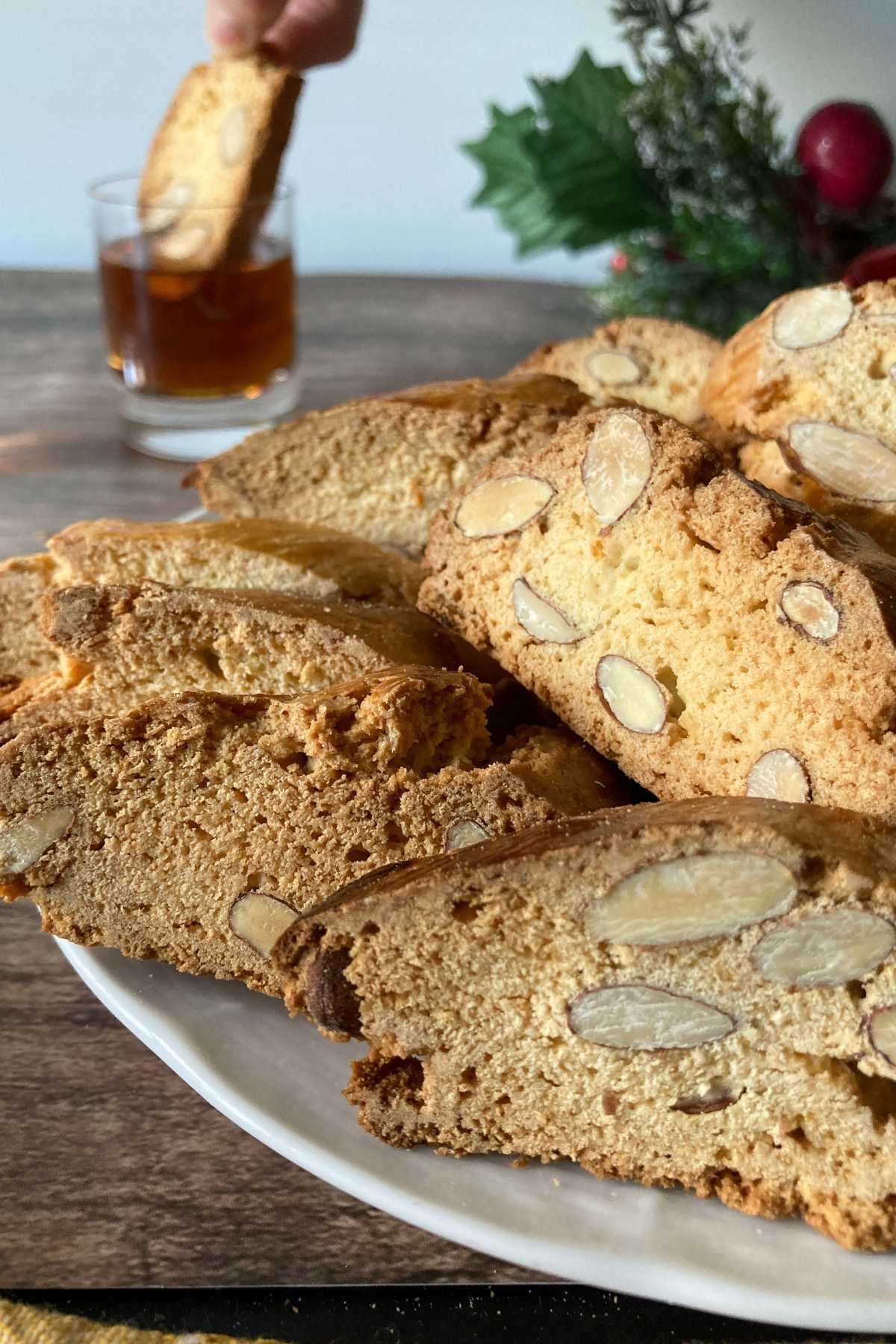
Crispy and scented, Cantucci are also known as "Biscotti di Prato", named after the Tuscan city where they apparently had their origins. Almond Cantucci Toscani, are the typical sweets of Tuscan cuisine, now widespread and loved throughout Italy and abroad.
They are the perfect Christmas cookies! Easy to make at home, you can make them as a gift to friends and family. They keep for a long time so they are perfect to store in your pantry for the arrival of your guests. Serve them on Christmas Eve, New Year's Eve and on parties along with liqueurs!
In fact, according to Tuscan tradition, the best way to enjoy cantucci is to dip them in Vin Santo, for a mouth-watering after-dinner treat. They are also excellent with Spumante or Moscato wine.
You can serve cantucci with a delicious Zabaglione or with Italian pastry cream. Actually, cantucci are also great on their own, maybe with a cup of tea. Any time of day is good for munching on them!
Here is the authentic Italian recipe for homemade cantucci. Follow it step by step and you will find that it's easier to make cantucci cookies at home than you can imagine!
Jump to:
Ingredients
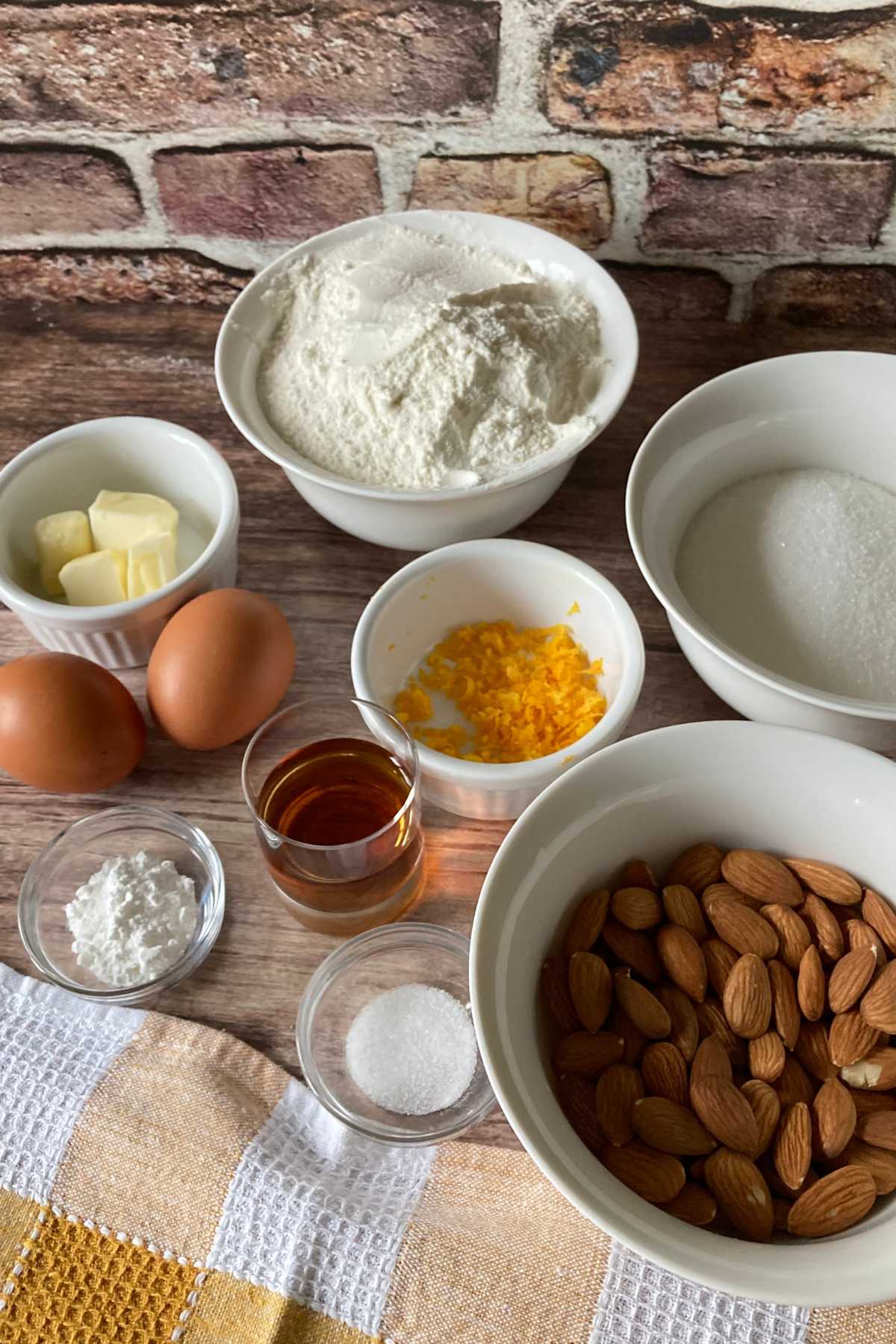
Prep Time: 15 Min | Cook Time: 30 Min | Servings: about 40 cantucci
- 150 g (¾ cup) granulated sugar
- 2 medium eggs
- 1 teaspoon baking powder
- 300 g (2 cups) of "00" flour
- 130 g (4.5 oz) of whole raw almonds
- 20 ml (2 tablespoons) of Marsala or other fortified wine
- zest of half orange
- 30 g (1 oz) of unsalted butter, at room temperature
- 1 egg yolk for brushing
- ⅙ teaspoon of fine salt
Instructions
Make the Dough

Step 1) - First, to make the cantucci recipe, place the sugar with the whole eggs and the fine salt in a large bowl.
Stir with a spatula to dissolve the sugar. It's not necessary to beat the eggs, just stir.

Step 2) - In a second bowl, mix the flour with the baking powder.
Then add the flour to the egg and sugar mixture.
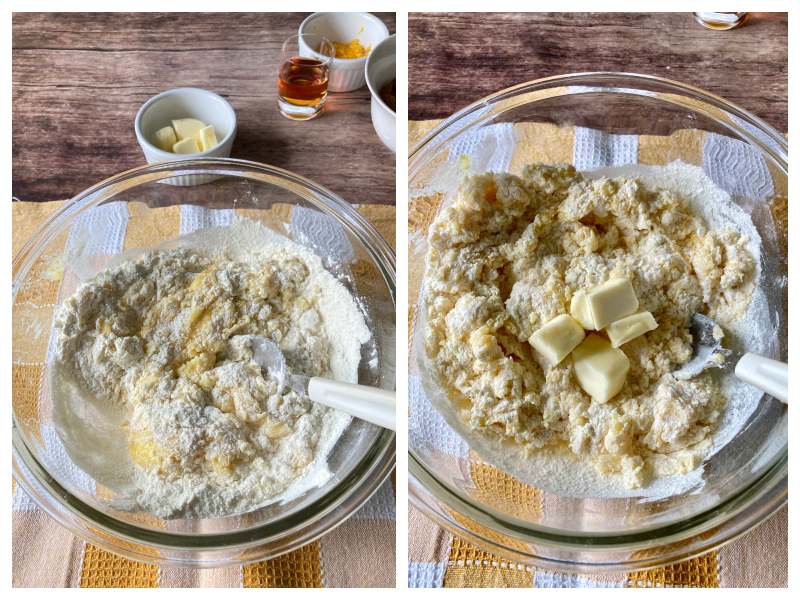
Step 3) - Mix very well with a spoon then add the soft butter at room temperature.

Step 4) - At this point the dough is very firm, so it's best to continue kneading with your hands.
Then add the whole almonds, marsala and orange zest.

Step 5) - Knead until all ingredients are well incorporated into the dough. If the dough sticks to your hands, add a little flour.
Now transfer the cantucci dough to a pastry board.

Step 6) - Knead some more and then divide the dough into two equal parts with a Dough Cutter. With your hands, roll the dough and form two long, rather narrow rolls.
Make the Cantucci

Step 7) - Line a baking sheet with baking paper and arrange the loaves well apart. Brush the surface with beaten egg yolk.

Step 8) - Bake at 180°C (356°F) in the middle part of the oven for about 20 minutes, the time it takes for the loaves to expand and flatten a bit.
Remove from the oven and let them cool.

Step 9) - Now you need to slice the loaves with a serrated blade.
Cut diagonal slices of the same thickness. About 1 ½ cm to at most 2 cm (½ inch to maximum ⅔ inch). The cantucci are almost ready! Arrange them on a baking sheet.

Step 10) - Arrange the cantucci on one side of a baking sheet covered with baking paper. Toast them in a preheated oven at 200°C (392°F) for 4 minutes on one side. Then turn them over and bake another 4 minutes on the other side.
In this way, the cantucci turn golden and get their characteristic crumbly texture.
Remove the cantucci from the oven and let them cool. Cantucci are ready!
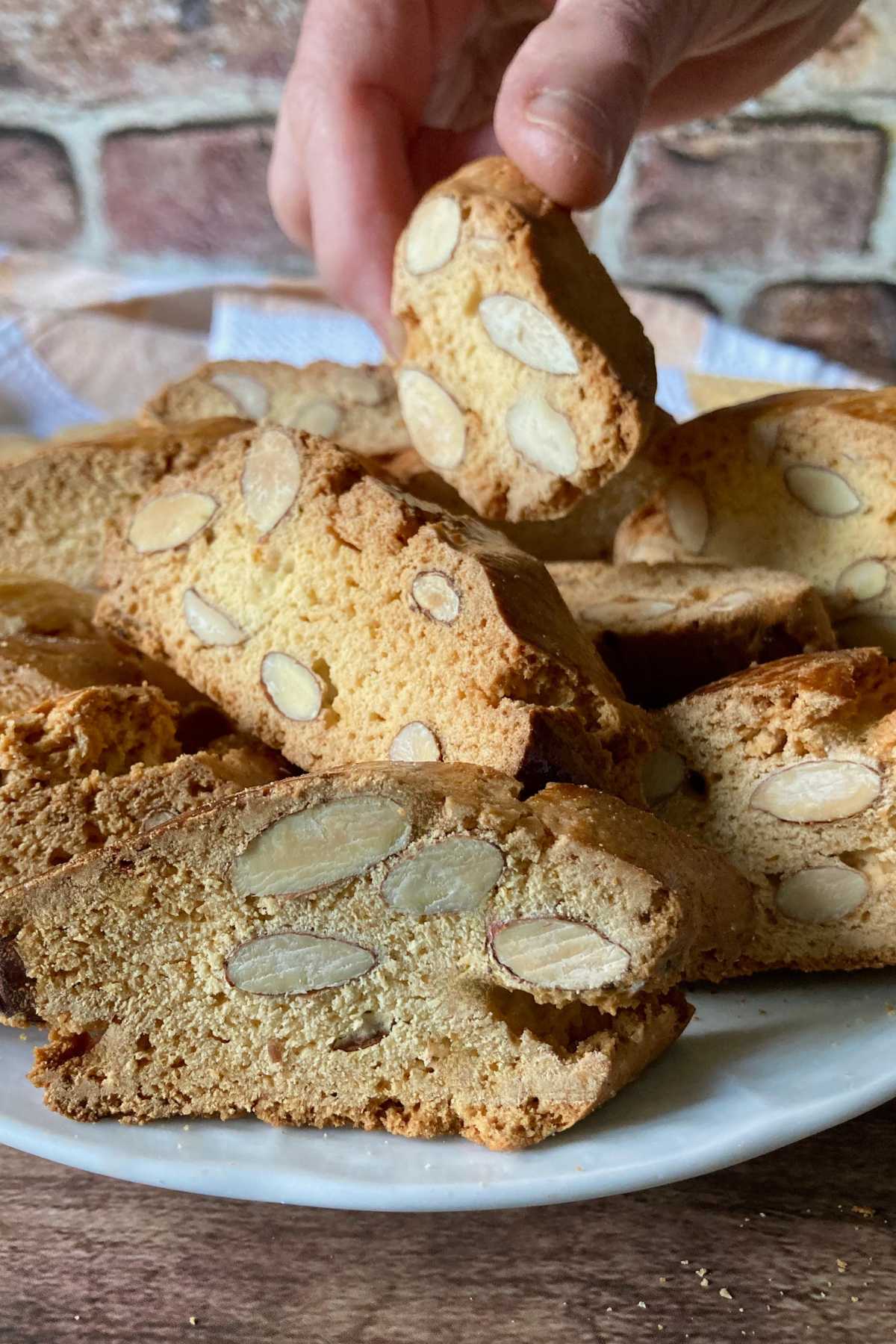
Storage
You can store Cantucci cookies at room temperature in a tin box or paper food bag for about 1 month.
Variations
Soft Cantucci
For a softer version of cantucci, simply skip the second bake. After baking the loaf, slice the cookies and let them cool directly on the warm baking sheet. The residual heat finishes the baking gently, keeping the cantucci tender.
Different Add-ins
Traditional cantucci are made only with almonds. However, you can customize them with other nuts like pistachios or hazelnuts, dried fruits such as raisins, or even chocolate chips and candied citrus. Some versions also include a spoonful of honey for extra flavor.
Lemon Cantucci
A citrusy twist replaces Marsala with limoncello and orange zest with lemon zest—think of it as a Neapolitan take on the classic Tuscan cookie.
Chocolate Cantucci
To make chocolate cantucci, use 250 g (2 cups) of flour and add 3 tablespoons of unsweetened cocoa powder. Swap in pistachios or a pistachio-almond mix for a vibrant contrast with the cocoa. The rest of the recipe stays the same.
Gluten-Free Cantucci
For a gluten-free version, replace 300 g (2½ cups) of flour with 150 g (1 cup) of corn flour and 140 g (1 cup) of rice flour. Follow the original recipe for the remaining steps.
Regional Versions
While Tuscan cantucci are the most famous, similar cookies appear across Italy with local twists:
- Tozzetti (Lazio and Umbria): often made with hazelnuts or other nuts.
- Stozze (Basilicata): very close to the Tuscan version.
- Tagliancozzi (Sicily): a sweeter variety from Marsala, typically served with Marsala wine instead of Vin Santo.
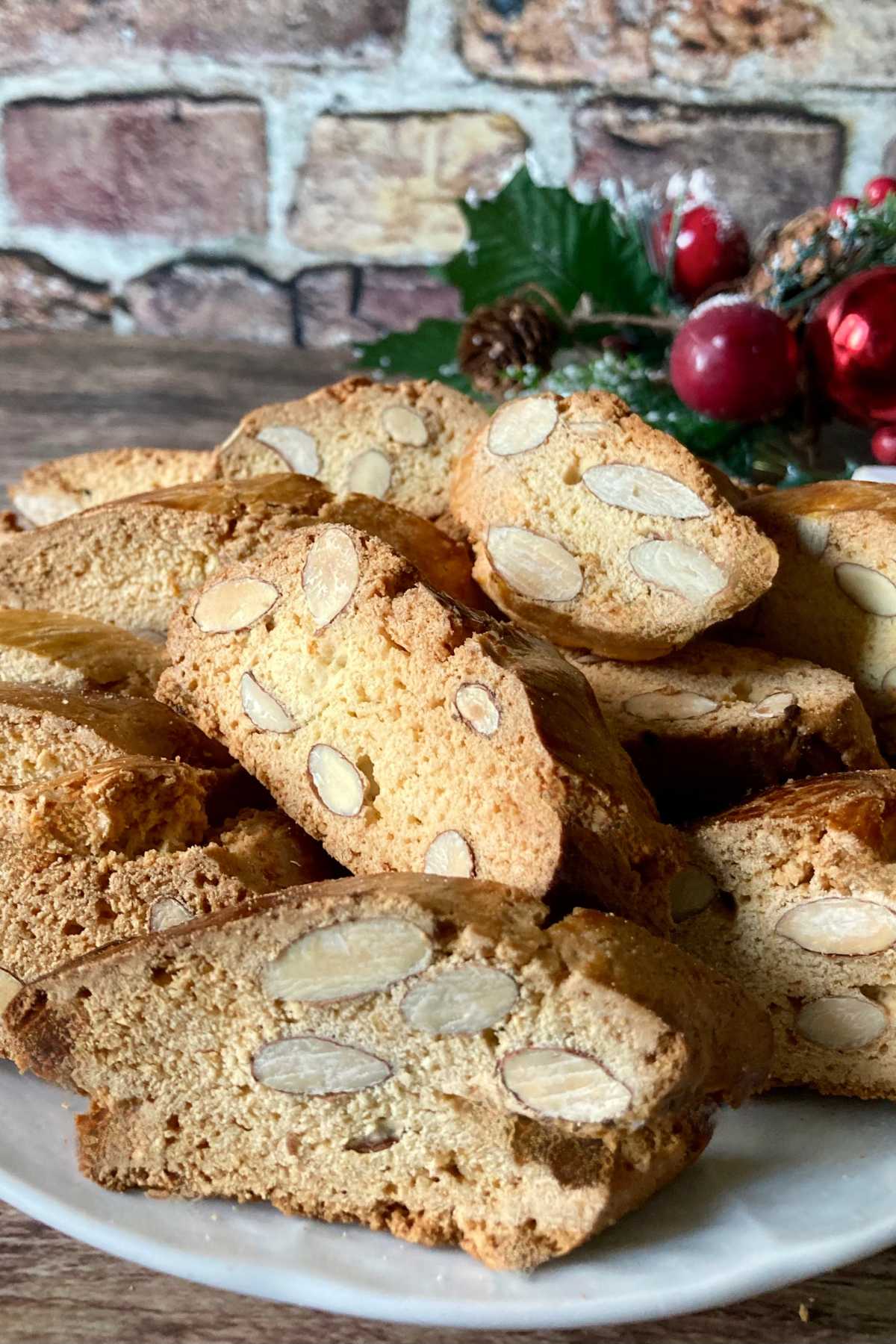
More Italian Cookies Recipes
- Sicilian Almond Cookies
- Italian Christmas Cookies
- Baci di Dama Cookies
- Amaretti Cookies Recipe
- Canestrelli Recipe
- Brutti ma Buoni
- Torcetti al Burro
History
Cantucci date back to at least the 16th century. The name likely comes from the Latin cantellus, meaning "piece of bread," once eaten by Roman soldiers. Others link it to the Italian canto, meaning "corner" or "small part."
By the late 1500s, cantucci appeared at the Medici court, though without almonds. The Accademia della Crusca first defined them in the 1600s as “sliced cookies made with flour, sugar, and egg white.”
The modern version was created in the mid-1800s by Antonio Mattei, a pastry chef from Prato. He refined the recipe, adding almonds, and introduced it at the 1867 Universal Exposition in Paris, where it was celebrated as a symbol of Italian excellence.
From 1900, almond cantucci entered large-scale production. In 2011, Tuscan producers formed an association to protect the recipe, achieving PGI status in 2016 for the entire Tuscany region.

FAQs about Cantucci
They’re essentially the same cookie. Cantucci, Cantuccini, Biscotti di Prato, and Biscotti Etruschi are all names for the same traditional Italian almond cookies, made by slicing a baked loaf of dough.
In Italy, the term Cantuccini is used when the cookies are smaller in size — it literally means “little cantucci.”
In Italy, especially in Tuscany, cantucci are traditionally served with Vin Santo, a sweet fortified wine. Dunking cantucci in Vin Santo isn’t just a custom — it’s a deeply rooted ritual!
Vin Santo is a sweet dessert wine made mostly from dried Trebbiano and Malvasia grapes. It pairs beautifully with dry pastries, and is considered the perfect match for cantucci.
“Vin Santo” means “Holy Wine.” The name likely comes from its historic use during religious ceremonies. According to legend, it was even offered to plague victims in the 1300s for comfort and relief.

Recipe Card

Cantucci Recipe (Traditional Tuscan Biscotti)
Ingredients
- 150 g granulated sugar - ¾ cup
- 2 eggs
- 1 teaspoon baking powder
- 300 g flour - 2 cups
- 130 g almonds, whole and raw - 4.5 oz
- 20 ml Marsala or other fortified wine - 2 tablespoons
- ½ orange zest
- 30 g unsalted butter - 1 oz, at room temperature
- 1 egg yolk - for brushing
- ⅙ teaspoon salt
Instructions
- Place the sugar with the whole eggs and the fine salt in a large bowl. Stir with a spatula to dissolve the sugar. It's not necessary to beat the eggs, just stir.
- In a second bowl, mix the flour with the baking powder.
- Then add the flour to the egg and sugar mixture.
- Mix very well with a spoon then add the soft butter at room temperature.
- At this point the dough is very firm, so it's best to continue kneading with your hands.
- Then add the whole almonds, marsala and orange zest.
- Knead until all ingredients are well incorporated into the dough. If the dough sticks to your hands, add a little flour.
- Now transfer the cantucci dough to a pastry board.
- Knead some more and then divide the dough into two equal parts with a Dough Cutter. With your hands, roll the dough and form two long, rather narrow rolls.
- Line a baking sheet with baking paper and arrange the loaves well apart. Brush the surface with beaten egg yolk.
- Bake at 180°C (356°F) in the middle part of the oven for about 20 minutes, the time it takes for the loaves to expand and flatten a bit.
- Remove from the oven and let them cool.
- Cut the loaves in diagonal slices of the same thickness. About 1 ½ cm to at most 2 cm (½ inch to maximum ⅔ inch). The cantucci are almost ready! Arrange them on a baking sheet.
- Arrange the cantucci on one side of a baking sheet covered with baking paper. Toast them in a preheated oven at 200°C (392°F) for 4 minutes on one side. Then turn them over and bake another 4 minutes on the other side. In this way, the cantucci turn golden and get their characteristic crumbly texture.
- Remove the cantucci from the oven and let them cool. Cantucci are ready!

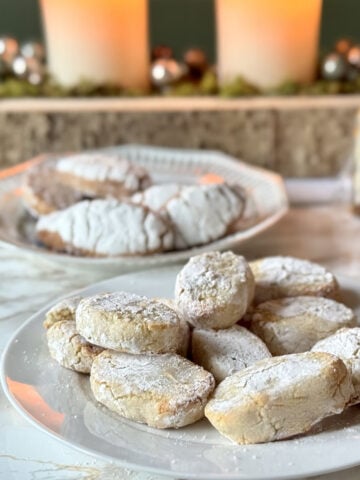



mitchell wilkins says
I've been using a recipe for about 40 years now from Giullano Bugialli. He says it's an absolute original and of course it has no oil nor butter in it. So is butter common in the Italian recipes? In italy? Making it without butter makes it very dry, hard, and very absorbent to sweet wine if you're dipping it.. ditto coffee. Just curious! I like your recipe as well!
Silvana Nava says
Hi Mitchell! Thank you so much for your thoughtful comment — and how amazing that you've been making cantucci for 40 years, following Bugialli’s original recipe! You’re absolutely right: the most traditional Tuscan cantucci (or biscotti di Prato) are made without butter or oil. They’re meant to be dry and crunchy, perfect for dipping in vin santo or coffee, just as you said.
However, over time, many Italian families and regions have come up with their own versions, sometimes adding a little butter to make them slightly softer and easier to bite into. It’s not part of the classic recipe, but it’s a common variation these days — especially for those who enjoy eating them on their own, without dipping.
So yes, butter isn’t in the strict traditional version, but it is found in many modern Italian recipes. I like to offer that slightly softer take as an option for those who prefer it that way
Thanks again for sharing your experience — I love hearing about different versions and traditions!